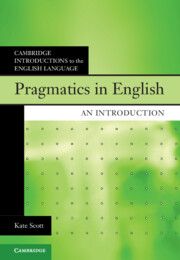Refine search
Actions for selected content:
3 results

Pragmatics in English
- An Introduction
-
- Published online:
- 29 December 2022
- Print publication:
- 29 December 2022
-
- Textbook
- Export citation
Chapter 1 - What Is Pragmatics?
-
- Book:
- Pragmatics in English
- Published online:
- 29 December 2022
- Print publication:
- 29 December 2022, pp 1-24
-
- Chapter
- Export citation
24 - Speech Acts, Discourse, and Clause Type
- from Part Five - Semantics and Pragmatics
-
-
- Book:
- The Cambridge Handbook of Romance Linguistics
- Published online:
- 23 June 2022
- Print publication:
- 07 July 2022, pp 728-762
-
- Chapter
- Export citation
